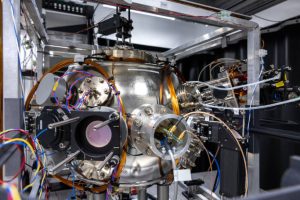Tokyo Institute of Technology scientist have discovered a promising proton conductor for protonic ceramic fuel cells. Ba2LuAlO5 “has a remarkably high proton conductivity, even without any additional chemical modifications”, according to the university. Protonic ceramic fuel cells use solid proton-conducting ceramic electrolytes and operate between 300 and 600°C. This compares to over 700°C for better-established solid-oxide fuel cells – where ...
Research
The latest electronics research news from within the industry and universities from around the world.
Can cartoon eyes help pedestrians trust autonomous cars?
Faced with an empty driving seat, pedestrians trust certain visual prompts when deciding whether to cross in front of an autonomous car, according to the University of Nottingham, which has studied such behaviour on its own campus. The study used a fake autonomous car, with a concealed human driver, equipped with animated display panels on its front that pedestrians could ...
Royal Navy tests quantum navigation sensor from Imperial College
An Imperial College prototype quantum accelerometer has been tested on a Royal Navy ship. The accelerometer uses ultra-cold atoms, whose wave-like properties allow them to be measured accurately by lasers as they move under acceleration. Quantum accelerometers and gyros are of enormous interest for inertial navigation systems as the quantum nature of the parameters measured have the potential to offer ...
Pressure sensor works up to 900°C
University of Houston researchers have used single-crystal aluminium nitride to make a pressure sensor that works up to 900°C. It follows a pressure sensors the same team made from single-crystalline gallium nitride, whose sensitivity dropped off above 350°C. “The team believed the decrease in sensitivity was due to the bandgap not being wide enough,” according to Houston. “To test the ...
Software to scan phones for abuse images is itself open to abuse
Software designed to detect child abuse images on smartphones, which could be mandated by governments in some counties, can be covertly repurposed to intrude on personal privacy, according to research at Imperial college. ‘Client-side scanning’ (CSS) is an image analysis technique based on ‘perceptual hashing’, and is mooted as a way to get around the legitimate problem of criminals hiding ...
Bio-electrodes are injectable temporary gels
Researchers at the Gwangju Institute of Science and Technology in Korea have developed injectable bio-electrodes with pre-settable lifetimes. “In recent times, conductible hydrogels have attracted great attention as bioelectrode materials owing to their flexibility, compatibility, and excellent interaction ability,” according to the Institute. “However, the absence of injectability and degradability in conventional conductive hydrogels limits their convenience of use and performance ...
Interns for innovation
Melexis is encouraging innovation and drawing on the rich pool of local technology graduates at its newly-opened Innovation Lab. Positioned in the Swiss canton of Neuchâtel, the Melexis Innovation Lab is the latest addition to the Belgian company’s site in Bevaix, near Geneva. The lab was opened in December 2022 and is a centre for pre-development of sensor technology products ...
Smallest holographic microscope needs smallest silicon LED ever
Claimed to be the smallest ever, a bright sub-wavelength silicon LED has been fabricated for use in a high-resolution lens-less holographic microscope, according to researchers at SMART in Singapore, the Singapore-MIT Alliance for Research and Technology. This form of microscope does not have conventional optics (see diagrams), but uses maths to reconstruct an image of the object from interference patterns. ...
Experimental process makes much of a wind turbine blade recyclable
Wind turbine blades can be recycled, at least partially, accoriding to researchers at Aarhus University in Denmark. The chemical process disassembles epoxy composite, releasing intact glass fibres and extracting one of the chemical component of the resin. Both are as good as new materials, according to the university, which added that the process could also be used with some materials ...
Photothermal resonance for micro-actuators?
Researchers in Japan have exploited resonance to get large amplitude motion from rod-like microcrystals, in a way that could be useful in soft robotics according to Waseda University. Using UV light, they set out to bend a particular type of 2,4-dinitroanisole crystals – chosen because of their large thermal expansion coefficient. The UV wavelength selected matches an absorption peak in ...
 Electronics Weekly Electronics Design & Components Tech News
Electronics Weekly Electronics Design & Components Tech News








